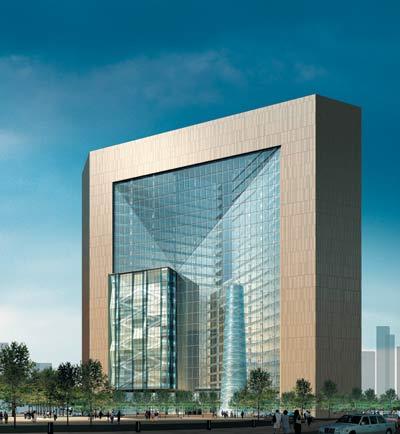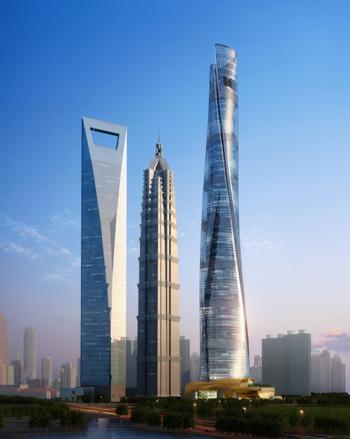华盛顿邮报:外国建筑师唱响中国天际(图)
http://www.sina.com.cn 2010年12月15日 10:52 新浪尚品
受到最近几十年中国空前建设力度的吸引,美国和欧洲的建筑设计师正大量涌入中国,将中国领导人大胆的设想变成钢筋混凝土的现实,给中国城市的天际线打上了一种独特的外国印记。
 北京新保利大厦
北京新保利大厦 上海金融中心
上海金融中心在许多西方国家的经济陷入停滞,许多建筑项目由于缺乏资金而被推迟或者规模被降低的时候,中国正在加大城市化的力度--建设新的办公塔楼、公寓楼、展厅、体育场馆、高速火车站、近100个新机场。这样大的建设力度向美国和欧洲建筑设计师提供了新的机会和经济生命线,他们业内的大部分业务仍处在艰难挣扎的状态。
包括北京新保利大厦和上海金融中心在内的许多现代中国的标志性建筑都是由美国和欧洲建筑设计师设计的。更多的项目正在建设中,一些项目的规模相当于整座城市,例如正在上海浦东建设的工业园区。中国所有的大城市看起来都正在建设或者扩建新的中央商务区或者金融中心,其规模通常相当于一个美国中等城市的中心城区。
自由的创新
外国建筑设计师称他们在中国设计建筑时可以拥有最大的创造性。美国SOM建筑师事务所中国区总监周学望称:“在中国,人们没有对建筑开发形成先入之见,这使年轻的建筑设计师有机会尝试新的想法。”
SOM在中国有32名雇员,正在中国进行50个项目,其中12个项目将在未来两年或三年完成。周学望称:“中国几乎就像是不同建筑设计师的一个实验室。”
许多由外国建筑设计师设计的最大型、最显眼项目是由政府出资的。清华大学建筑教授彭培根和其他人称,中国官员和一些私人开发商经常倾向使建筑项目能有一个国际名字,希望借此使建筑项目成为地标建筑。
本地人才的缺乏
中国也有自己的建筑设计师,但建筑设计师作为一项职业只是在二十世纪八十年代才被官方承认,这使中国本土有经验的设计师数量非常少。
更少的政府审批手续
对美国建筑师的另一吸引力在于能够在几年内就完成建筑项目的设计、建设、投入日常使用。与此形成对比的是,在美国,由于各种繁琐的政府手续,建设项目通常需要十多年才能最后开发完成,完成时间经常要比这还要长。
数位建筑设计师称,开发速度也带来了其自身的挑战,其中的一个挑战是外国建筑设计师建设环境可持续型建筑物和城市的愿望经常与当地建设速度快、造价要低的迫切需要相冲突。
例如,一位美国建筑设计师称,在美国,建筑物通常的设计使用寿命在75年至100年。但是在中国,私人开发商通常要求建筑物的设计使用寿命最长不要超过三十年。他说:“他们对建筑物的想法就像它是一个商品,它是用完即可丢弃的。”
Foreign architects put stamp on Chinese skyline
Drawn by a building boom unmatched in the world in recent decades, U.S. and European architects are flocking to China, turning Chinese leaders' bold visions into concrete and steel realities and giving Chinese cityscapes a distinctly foreign signature。
At a time when many Western economies are stagnant and many construction projects have been delayed or scaled back for lack of financing, China is on a major push to urbanize - building new office towers, apartment blocks, exhibition halls, stadiums, high-speed train stations and nearly 100 new airports. The boom is offering U.S. and European architects new opportunities and an economic lifeline, as much of their industry is struggling。
Many of modern China's iconic structures, including the New Poly Plaza and the World Trade Center in Beijing and the Shanghai World Financial Center, have been designed by U.S. and European architects。
Many more projects are in the works - in some cases, the equivalent of entire cities, such as the sprawling industrial park being built in Shanghai's Pudong area. Every major city, it seems, is building or expanding a new central business district or financial center - often the size of the downtown of a midsize American city。
Foreign architects have been working in China since the late 1990s. But the real construction boom began in 2001, just as work slowed in the United States. China's government estimates that 300 million people - about the population of the United States - will move into urban areas in the next 15 years。
"Train stations, airports - they really need everything," said Martin Hagel, senior architect with the German firm GMP, based in Shanghai. "It's a place where architects want to be." He added, "The scale of things is unbelievable - building a new city is something you don't get to do often."
And, while many U.S. developers have been wary of skyscrapers since the Sept. 11 attacks, China is a place where American architects say they can build big and tall。
Paul Katz of the New York firm Kohn Pedersen Fox, or KPF, said, "When people in the U.S. were not building tall buildings, we were here building tall buildings." Standing on the firm's Shanghai office balcony, with sweeping views of the city, Katz said, "There's hardly a building you see today that stood 15 years ago."
Free to innovate
China is also a place where foreign architects say they can be their most creative。
In China, "people have no preconceived notion of what building development should be," said Silas Chiow, China director for the U.S. firm Skidmore Owings Merrill, or SOM. "That gives young architects an opportunity to try new ideas."
SOM designed Shanghai's Jin Mao tower, one of the most visible buildings on the Pudong skyline, with its traditional Chinese style, as well as Beijing's New Poly Plaza, with the world's largest cable-net-supported glass wall, and Tower III of the World Trade Center in Beijing. SOM also designed the futuristic car-shaped Pearl River Tower, with wind turbines and solar panels。
SOM has 32 employees in China and is working on 50 projects in the country, with a dozen due to be completed in the next two or three years. "China is almost like an experimental laboratory for different architects," Chiow said。
That has drawn some criticism. A few high-profile Chinese architects and critics say some foreign designers are ignoring Chinese culture and traditions and turning China into a showcase of weirdly shaped structures better left on the drafting table。
"They're using China as their new weapons testing zone," said Peng Peigen, a well-known architect and professor at Tsinghua University in Beijing. "These kind of stupid things they build could never be built in their own countries, in this life, the last life or the next life."
Peng praised "95 percent" of the many foreign architects in China. But he said the other 5 percent are ignoring the basic design rule that "form follows function." He criticized the Swiss-designed "Bird's Nest" stadium, used for the 2008 Olympics, as an "atrocious design" with a top-heavy roof, and called the French-designed National Grand Theater, known as "The Egg," a dysfunctional and "almost dangerous" eyesore。
Local shortage
Many of the largest, most visible projects designed by foreign architects are government-funded, and Peng and others said Chinese officials - and some private developers - often prefer to see an international name on a structure that they hope will become a landmark。
China has its own architects, but, as Peng noted, the communists who came to power in 1949 did not respect architecture as a profession. Since then, it has been officially recognized only since the 1980s, leaving too few experienced local architects。
James Shen, a 33-year-old architect from Orange County, Calif., came to China with recommendations from his Massachusetts Institute of Technology professor, a renowned Chinese architect who had previously led the architecture department at Peking University. In China, Shen said he discovered that "a lot of Chinese clients want foreign architects because they think they'll do better-quality stuff."
Shen, who specializes in product design, also said some foreign architects are designing buildings that Chinese simply find odd or aesthetically inaccessible. "When they're finished, people don't always have a relationship with them," said Shen. He started his own company, People's Architecture Office, because "we wanted to approach design in a way people can relate to it," he said。
U.S. and European architects say it is an unparalleled chance to show off their expertise, experiment with cutting-edge designs, use new energy-efficient "green" technologies, and, for young architects, an opportunity to gain experience on a massive scale。
Chiow graduated with an architecture degree from Washington University in 1985 and relocated to Shanghai in 2004 for SOM. While there is no official count on the number of foreign firms working in China, Chiow said, "All the major American practices are here."
"I'm just fascinated by the urbanization happening in China - and the speed of it," said Chiow, 51. "What China has been able to build in the last 15 years took the U.S. over a hundred years."
For Chiow, who is Chinese American, working in China has an added attraction. "I'm learning about my heritage every day," he said。
Less bureaucracy
Another lure for U.S. architects is the chance to see a project designed, built and in regular use in as little as a few years. In the United States, by contrast, with various bureaucratic hassles, projects can typically take more than a decade to come to fruition, and often much longer。
The speed of development brings its own challenges, several architects said. Among them, the foreign architects' desire to build environmentally sustainable buildings and cities often run smack into the local imperative to build it quickly - and often build it cheaply。
For example, an American architect said that in the United States, buildings are typically designed to last 75 to 100 years, with many of the best-known and best-loved buildings, such as New York's Empire State Building, gracefully entering late middle age. But in China, he said, the private developers often want "a building to last 30 years" maximum. "Their idea of a building is like a commodity. It's disposable."
(华盛顿邮报)
(解雨)
